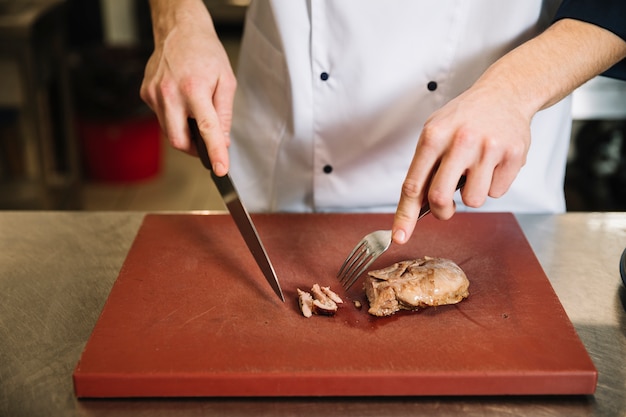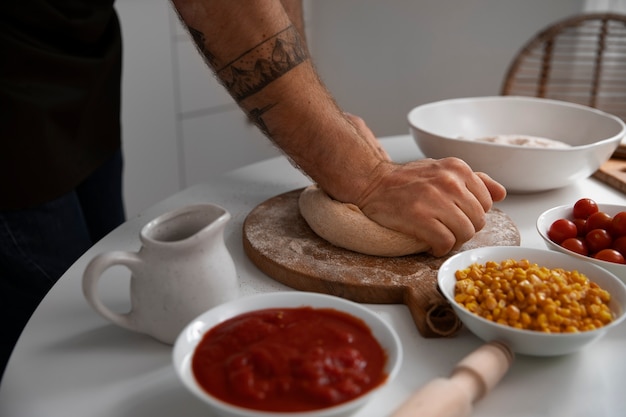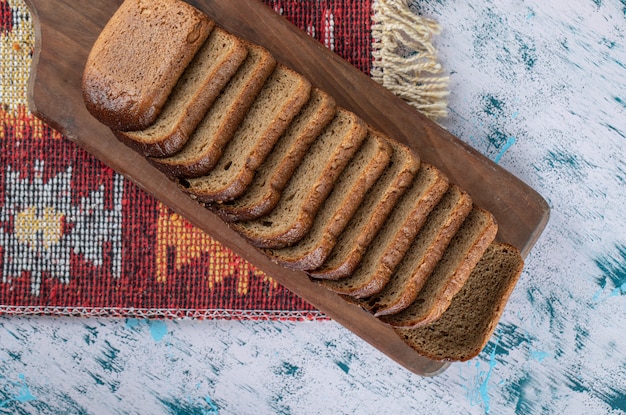Meatloaf. Just the word conjures up memories of cozy dinners, warm aromas filling the kitchen, and the comforting taste of a classic dish. It's a true kitchen chameleon, adaptable to countless flavors and textures. But, there's one question that often leaves us stumped: how long do we bake a 2-pound meatloaf?
Fear not, fellow meatloaf enthusiasts! We're about to embark on a journey to demystify meatloaf cooking times, armed with tips, tricks, and personal anecdotes to guide you toward a perfectly cooked, flavorful masterpiece.
The Factors Influencing cooking time: Unraveling the Meatloaf Mystery

Before we dive into the specifics, let's address the elephant in the room: there's no one-size-fits-all answer. The perfect meatloaf cooking time depends on a few key factors. Understanding these will ensure your loaf is cooked through without becoming dry. Think of it as a culinary detective story, where we're piecing together clues to crack the code for perfect meatloaf.
1. Shape of the Loaf: Round vs. Rectangular
This might sound trivial, but it's a crucial factor. A round meatloaf tends to cook faster than a rectangular one. Why? It's all about how heat reaches the center. A round shape allows the heat to penetrate more evenly, reaching the center more quickly.
Think of it this way: imagine baking a cake. A round cake pan will cook more evenly than a rectangular one because the heat can reach the center more easily. The same principle applies to meatloaf.
2. Oven Temperature: Not All Ovens Are Created Equal
Ever baked something and wondered why it didn't turn out right? It could be your oven's temperature! Ovens can vary in their accuracy, and even a slight deviation can affect the cooking time. My advice? Invest in an oven thermometer. It's a lifesaver, especially when it comes to meatloaf.
I once baked a meatloaf at 350°F (175°C), relying solely on my oven's internal thermometer. It turned out slightly undercooked. I invested in an oven thermometer, and let me tell you, the difference was night and day! It's a small investment for peace of mind and a perfectly cooked meatloaf.
3. Size of the Loaf: Bigger is Not Always Better (at Least When it Comes to Cooking Time)
Obviously, a larger meatloaf will take longer to cook through than a smaller one. That 2-pound loaf we're focusing on will probably need an hour or more.
I remember making a giant 3-pound meatloaf for a family gathering. It took almost an hour and a half to bake! So, keep the size in mind when planning your meatloaf journey.
4. Ingredients: More Than Just Meat!
Your meatloaf's ingredients play a crucial role in determining cooking time. A meatloaf loaded with vegetables or high-moisture ingredients like tomatoes will take a bit longer to cook through. Those ingredients hold onto moisture, slowing down the heat transfer process.
Think of it as a puzzle: the more ingredients you add, the more pieces you need to fit together, and the longer it takes to solve the puzzle (or in our case, cook the meatloaf).
5. The Baking Pan: Light or Dark, It Matters
Believe it or not, the baking pan you use can impact cooking time. A darker-colored pan absorbs more heat, leading to faster cooking. Conversely, a light-colored pan or a glass baking dish reflects more heat, which can slow down the cooking process.
For a more even cooking experience, I usually opt for a light-colored metal pan or a glass baking dish. This helps prevent over-browning on the outside before the center is cooked. It's all about finding that happy medium.
(Part 1) - The Basics: Cooking Time for a 2-Pound Loaf

Now, let's tackle the big question: how long should you bake a 2-pound meatloaf? As a general rule of thumb, you can expect to bake a 2-pound meatloaf at 350°F (175°C) for about 1 hour to 1 hour and 15 minutes. But remember, this is just a starting point. Every oven, recipe, and ingredient combination is unique.
The best way to ensure your meatloaf is cooked through is by using a meat thermometer. It's a kitchen essential, especially for meatloaf, and will eliminate any guesswork. The internal temperature should reach 160°F (71°C) for safe consumption. However, I've found that a slightly higher temperature of 165°F (74°C) yields a more juicy and flavorful result.
Think of the meat thermometer as your trusty sidekick, always there to ensure your meatloaf is perfectly cooked, safe, and bursting with flavor.
Visual Cues: Recognizing a Perfectly Cooked Meatloaf
While a meat thermometer is the ultimate judge, there are a few visual clues that can help you determine if your meatloaf is ready:
- Firm to the Touch: A cooked meatloaf should feel firm and stable when you press on it gently. It shouldn't wobble or jiggle.
- Deep, Even Brown Surface: This indicates that the exterior is cooked through, a sign that the interior is likely to be cooked as well.
- No Pink Shows When You Slice: If you slice into the meatloaf and see any pink, it's not done yet. Return it to the oven for another 10-15 minutes.
(Part 2) - Let's Talk About Oven Temperatures: A Culinary Temperature Guide

Choosing the right oven temperature is crucial for achieving the perfect meatloaf. It can make the difference between a juicy, tender loaf and a dry, crumbly one. Let's explore the common temperature options for meatloaf and their effects:
1. High Heat (375°F - 400°F): For a Crispy Exterior
This approach is great if you want a crispy exterior and a slightly faster cooking time. However, it can lead to a drier meatloaf if you're not careful. Keep a close eye on your meatloaf and check for doneness regularly.
Think of it like grilling a steak: high heat creates a delicious sear on the outside, but you have to be careful not to overcook it.
2. Medium Heat (350°F): The Goldilocks Zone
This is my go-to temperature for meatloaf. It's a happy medium, delivering a crispy exterior while preserving a juicy interior. The cooking time is a bit longer, but it's worth it for the results.
I find that medium heat provides a balance that's hard to resist. It's like finding that perfect spot on the beach: not too hot, not too cold, just right.
3. Low Heat (325°F): For Tender and moist meatloaf
If you're worried about overcooking a meatloaf with a high moisture content, low heat is your best friend. It takes longer to reach the desired internal temperature, but it results in a more tender and moist meatloaf.
Think of it as a gentle, slow-cooked stew: low heat allows the flavors to meld and the meat to become incredibly tender.
(Part 3) - Troubleshooting Common Meatloaf Mishaps: A Culinary Crisis Manager
We've all been there. You've poured your heart and soul into creating the perfect meatloaf, only to be met with a dry, crumbly, or worse, undercooked disaster. But don't despair! Let's delve into some common meatloaf woes and how to avoid them.
1. A Dry Meatloaf: The Culinary Drought
A dry meatloaf is a culinary tragedy. It can happen for a few reasons:
- Over-mixing the Mixture: Overworking the meatloaf mixture can lead to a dry loaf. The gluten in the breadcrumbs can develop too much, squeezing out the moisture. Aim for just enough mixing to combine the ingredients without overworking the mixture.
- Too Much Breadcrumbs: The breadcrumbs are the sponges of the meatloaf world, soaking up all the moisture. Use less breadcrumbs, or opt for a drier bread like stale bread, to prevent excessive dryness.
- Overcooking: Overcooked meatloaf is like a dried-out sponge, lacking any moisture and flavor. Use a meat thermometer to ensure it's cooked through without overdoing it.
2. A Crumbly Meatloaf: The Culinary Crumble
A crumbly meatloaf is a sign of a lack of binding agents. Here's how to prevent this:
- Use the Right Breadcrumbs: Choose fine, dry breadcrumbs specifically designed for binding. Avoid coarse, wet breadcrumbs, which won't hold the meatloaf together.
- Mix Gently: Over-mixing can break down the binding agents, leading to a crumbly loaf. Mix just enough to combine the ingredients.
- Add a Binding Agent: If your meatloaf is still too crumbly, add a little extra binding agent, like egg, milk, or even a bit of mustard.
3. A Meatloaf that Falls Apart: The Culinary Collapse
This is usually caused by not enough binding agents or by over-mixing the mixture. Here's how to ensure a cohesive loaf:
- Ensure Enough Binding Agents: Make sure you're using a sufficient amount of breadcrumbs, eggs, and other binding agents, like milk or mustard. These ingredients help hold the meatloaf together.
- Mix Gently: As mentioned earlier, over-mixing can break down the binding agents. Mix just enough to combine the ingredients.
- Shape the Loaf Properly: When shaping the meatloaf, press it firmly into the baking dish. This will help to compact the loaf and prevent it from falling apart.
(Part 4) - meatloaf variations and Tips: A Culinary Playground
The beauty of meatloaf lies in its versatility. You can customize it to your heart's content, adding different seasonings, vegetables, cheeses, and even glazes. Let's explore some ideas to unleash your inner meatloaf maestro:
1. Savory flavor combinations: A Symphony of Taste
- Classic: A blend of onion, garlic, parsley, and Worcestershire sauce is a timeless classic. This combination provides the foundation for countless meatloaf recipes.
- Italian: Add oregano, basil, and a touch of red pepper flakes for an Italian twist.
- Mexican: Spice things up with cumin, chili powder, and paprika. Add some chopped bell peppers for extra flavor and texture.
2. Vegetable Additions: A Culinary Garden
- Classic: Finely chopped onion and celery are common additions to meatloaf. They add moisture and depth of flavor.
- Hearty: For a more substantial meatloaf, add diced carrots, mushrooms, or finely chopped potatoes.
- Flavorful: Add some chopped bell peppers, zucchini, or eggplant for a burst of color and flavor.
3. Cheese Accents: A Touch of Creamy Goodness
- Traditional: A simple layer of cheddar cheese is a classic addition to a meatloaf.
- Fancy: For a more gourmet touch, try using a blend of Gruyère and Parmesan cheese.
- Creamy: Add some cream cheese to the meatloaf mixture for a richer, creamier flavor.
4. Glaze Ideas: A Culinary Finishing Touch
A glaze can transform a simple meatloaf into a show-stopping centerpiece. Here are some ideas to try:
- Sweet and Savory: A mixture of brown sugar, ketchup, and Worcestershire sauce is a classic and delicious glaze.
- Spicy: Add a touch of heat with a glaze made with sriracha, honey, and a pinch of cayenne pepper.
- Tangy: A balsamic vinegar glaze adds a touch of sweetness and acidity.
5. Other Tips: A Culinary Toolkit
- Don't Over-Handle the Mixture: Over-mixing the meatloaf mixture can make it tough. Handle it gently.
- Use a Meat Thermometer: It's the best way to ensure your meatloaf is cooked through and safe to eat.
- Let the Meatloaf Rest: After baking, let the meatloaf rest for 10-15 minutes before slicing. This will allow the juices to redistribute, preventing a dry loaf.
(Part 5) - The Importance of Resting Your Meatloaf: A Culinary Relaxation
Just like a juicy steak, meatloaf benefits from a little rest after baking. This allows the juices to redistribute throughout the loaf, resulting in a more tender and flavorful slice. Think of it as a culinary massage. It's worth those extra 10-15 minutes to allow those flavors to settle in!
(Part 6) - Meatloaf Storage and Leftovers: A Culinary Treasure Chest
You've created a delicious meatloaf, and now you have some leftovers. No worries! Proper storage will ensure your meatloaf stays fresh and flavorful for days. Here's what I do:
- Let it Cool: Once your meatloaf is out of the oven, let it cool completely before storing it. This will help prevent condensation from forming, which can make the meatloaf soggy.
- Wrap it Up: Wrap the cooled meatloaf tightly in plastic wrap or aluminum foil. This will help prevent it from drying out.
- Store in the Fridge: Store the wrapped meatloaf in the refrigerator for up to 4 days.
Reheating Tips: Bringing Back the Flavor
When it's time to enjoy those leftover meatloaf treasures, here are a few ways to reheat it:
- Oven: Reheat the meatloaf in a preheated oven at 350°F (175°C) for about 20-30 minutes, or until heated through.
- Microwave: Reheat the meatloaf in the microwave on high for about 1-2 minutes per slice, or until heated through.
- Skillet: Heat a little oil in a skillet over medium heat. Add the slices of meatloaf and cook for about 2-3 minutes per side, or until heated through and browned.
(Part 7) - Beyond the Traditional Loaf: Meatloaf Variations
Meatloaf doesn't have to be a traditional, rectangular loaf. Let's explore some fun and creative variations on this classic dish:
1. Mini Meatloaf Muffins: A Culinary Delight
These adorable individual meatloaf muffins are perfect for a crowd or for portion control. They're a great way to add a touch of whimsy to your meal. Just divide the meatloaf mixture among muffin tins, bake for about 20-25 minutes, and you've got a delightful bite-sized treat.
2. Meatloaf Balls: A Playful Twist
For a fun twist, try making meatloaf balls! Simply shape the meatloaf mixture into small balls, bake them for about 20-25 minutes, and serve them with your favorite dipping sauce. These are great for a party or a quick and easy dinner.
3. Stuffed Meatloaf: A culinary adventure
Get creative with your fillings! You can create a layered meatloaf with a mixture of cheese, vegetables, or even a savory stuffing.
(Part 8) - FAQs About Meatloaf Cooking Time: A Culinary FAQ Guide
Here are some of the most common questions people have about meatloaf cooking time, and my answers based on my experience:
1. How Long Should I Bake a 2-Pound Meatloaf at 325°F?
A 2-pound meatloaf baked at 325°F will take about 1 hour and 30 minutes to 1 hour and 45 minutes to reach an internal temperature of 160°F (71°C). Keep in mind that the exact cooking time will depend on your oven and the specific ingredients you use.
2. Can I Overcook Meatloaf?
Absolutely! Overcooking meatloaf will lead to a dry, tough loaf. Use a meat thermometer to make sure it's cooked through without overdoing it. The ideal internal temperature for meatloaf is 160°F (71°C), but I prefer a slightly higher temperature of 165°F (74°C) for a more flavorful and juicy result.
3. How Do I Know When My Meatloaf is Done Without a Thermometer?
While using a meat thermometer is the most accurate way to determine doneness, you can also look for visual cues. A cooked meatloaf will be firm to the touch, the surface will be a deep brown color, and you shouldn't see any pink when you slice into it.
4. What Happens if I Don't Let My Meatloaf Rest After Baking?
If you don't let your meatloaf rest, the juices won't have a chance to redistribute, and the meatloaf will be more likely to be dry and crumbly. Allowing the loaf to rest for 10-15 minutes before slicing will result in a more juicy and flavorful meatloaf.
5. What Can I Do If My Meatloaf is Undercooked?
If your meatloaf is undercooked, simply pop it back in the oven for another 10-15 minutes. Check the internal temperature with a meat thermometer to make sure it reaches 160°F (71°C) before serving.
There you have it, folks! My comprehensive guide to meatloaf cooking time and all things meatloaf. Remember, practice makes perfect. Don't be afraid to experiment with different ingredients, seasonings, and cooking techniques. You'll discover your own preferred methods and create a delicious meatloaf that's perfect for your taste buds. Happy cooking!
Everyone is watching

How to Cook Frozen Lobster Tails Perfectly: A Step-by-Step Guide
RecipesLobster. Just the word conjures up images of lavish meals, special occasions, and a taste of luxury. But let's...

Pigs in a Blanket Cooking Time: How Long to Bake for Perfect Results
RecipesAh, pigs in a blanket. Just the name conjures up images of those delightful little parcels of crispy pastry en...

Pork Fillet Cooking Time: How Long to Cook It Perfectly
RecipesPork fillet, or tenderloin as it's sometimes called, is a real favourite in our house. It's so versatile, and...

The Ultimate Guide to Tender, Juicy Pulled Pork
RecipesRight, let's talk pulled pork. It's one of those dishes that just screams "comfort food," doesn't it? I mean...

The Ultimate Guide to Cooking Sweet Potatoes: From Roasting to Mashing
RecipesSweet potatoes. Just the name conjures up images of warm, comforting dishes, bursts of vibrant color, and a to...
